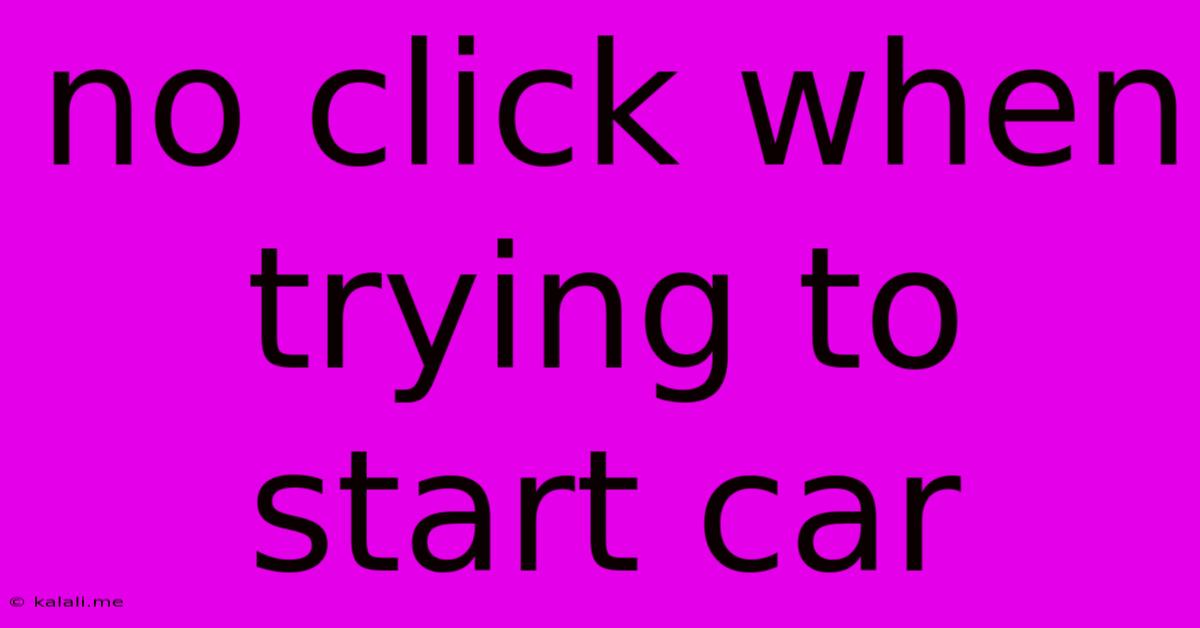No Click When Trying To Start Car
Kalali
Jun 03, 2025 · 3 min read

Table of Contents
No Click When Trying to Start Your Car: Troubleshooting Guide
Meta Description: Experiencing a "no click" when trying to start your car? This comprehensive guide covers common causes, from dead batteries to faulty starters, and provides troubleshooting steps to get you back on the road.
A "no click" when you turn your car's ignition is a frustrating experience, leaving you stranded and wondering what went wrong. This isn't the same as a slow cranking or clicking sound – we're talking complete silence. Fortunately, diagnosing the issue is often simpler than you might think. This guide will walk you through the common culprits behind a no-click start and offer troubleshooting solutions.
1. The Most Likely Culprit: A Dead Battery
The most frequent reason for a no-click start is a completely discharged battery. Over time, batteries lose their charge, especially if you frequently use accessories like headlights or the radio without the engine running. Cold weather can also significantly impact battery performance.
-
How to Check: Use a multimeter to test your battery voltage. A healthy battery should read around 12.6 volts. Anything significantly lower indicates a dead or weak battery. If you don't have a multimeter, try jump-starting your car. If it starts, the battery is likely the problem.
-
Solution: Charge your battery using a battery charger or replace it with a new one. Always follow the manufacturer's instructions when working with car batteries.
2. Corroded Battery Terminals
Even if your battery has sufficient charge, corroded battery terminals can prevent the electrical current from flowing properly. Corrosion builds up over time and restricts the connection between the battery and the car's electrical system.
-
How to Check: Inspect the battery terminals for white, green, or bluish-white crusty deposits.
-
Solution: Carefully clean the terminals with a wire brush or terminal cleaner. Make sure to disconnect the negative terminal first (usually black) and then the positive terminal (usually red) before cleaning. Reconnect the terminals after cleaning, ensuring a tight connection.
3. Faulty Starter Motor
The starter motor is the component responsible for cranking the engine. A faulty starter can prevent the engine from turning over, resulting in a no-click situation. This often involves internal component failure within the starter itself.
-
How to Check: This is more difficult to diagnose without specialized tools. Listening carefully for any unusual sounds (like a faint whirring or grinding) when you turn the ignition can be a clue, but often, a professional mechanic needs to test the starter motor directly.
-
Solution: Replacement of the starter motor is generally required. This is best left to a professional mechanic.
4. Issues with the Ignition Switch
The ignition switch is the part that sends power to the starter motor when you turn the key (or press the start button). A malfunctioning ignition switch can cut off the electrical circuit, leading to a no-click start.
-
How to Check: This requires some electrical testing, and typically involves checking for continuity between the ignition switch and the starter motor. Again, this is best left to a qualified mechanic.
-
Solution: Replacement of the ignition switch is the most common solution.
5. Loose or Damaged Wiring
Loose or damaged wiring in the electrical system leading to the starter can also be responsible. A break in the circuit will prevent the starter from receiving the necessary power.
-
How to Check: A thorough visual inspection of all wires connected to the battery, starter, and ignition system is necessary. Look for any signs of fraying, breakage, or loose connections.
-
Solution: Repair or replace any damaged wiring. This is often a complex task that requires electrical knowledge and should be done by a qualified mechanic.
Getting Back on the Road
While diagnosing a no-click start often involves some troubleshooting, identifying the source of the problem can be done systematically. Starting with the simplest solutions like checking the battery and terminals is your best first step. If the problem persists, it's always advisable to consult a qualified mechanic to avoid further damage to your vehicle's electrical system. Remember safety first – always disconnect the negative battery terminal before undertaking any electrical repairs.
Latest Posts
Latest Posts
-
Secure Email Cannot Reset Password Security Questions Incorrect
Jun 05, 2025
-
Wheres My Goddamn Electric Car Bruce
Jun 05, 2025
-
How Long Does Mint Take To Grow
Jun 05, 2025
-
How To Get Rid Of Bunnies In Backyard
Jun 05, 2025
-
Remove Shelf From Bottom Of Screan
Jun 05, 2025
Related Post
Thank you for visiting our website which covers about No Click When Trying To Start Car . We hope the information provided has been useful to you. Feel free to contact us if you have any questions or need further assistance. See you next time and don't miss to bookmark.